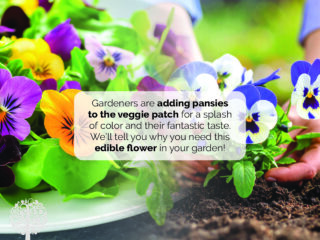Pansies are bright, cool-season annuals that add new flavor to the veggie patch
Pansies are a whimsical flower. Their small petals and bright colors in early spring and fall feel like fairy dust sprinkled throughout the garden or on a salad. Pansies are edible; their petals taste like mint, and their leaves like spinach. The plant contains vitamins A, C, and E, as well as iron, fiber, potassium, and calcium, making it a nutritional essential for the edible garden.

How to Grow Pansies
Buy pansies from most big-box stores or garden centers. However, if you plan to grow them for food, the best way to ensure that the plants haven’t been treated with synthetic fertilizer is to start them from seeds. Seeds can be planted directly into the garden, but for best results, indoor seeding is recommended, with temperatures maintained at a steady 65 to 75°F. (18-24°C). Find organic pansy seeds in store, or source them online from a variety of sellers.
Pansies are happiest in loose, rich soil amended with compost. After filling the seed trays with soil, surface-sow the pansy seeds. Cover the seed tray with a dark lid that prevents light from penetrating, and place it in a cool location. For germination to be successful, the soil needs to remain damp but not overly saturated with water. Once the seeds have germinated, uncover the tray and move it into the light. Wait until the plants have sprouted four or five leaves before transplanting them outdoors.
When and How to Plant Pansies
Pansies are hardy, so as soon as the soil can be worked in spring, they can be planted outdoors. Fall-sown pansies can be transplanted as soon as the temperatures start to cool in autumn. When planting in a garden bed, leave 6 to 12 inches of space between each plant to allow them room to grow. For container planting, avoid crowding the plants. Three to four pansy plants in a 10- to 12-inch pot is ideal. Plant in partial shade and rich, well-draining soil, and water regularly, but avoid overwatering.
Pansies in the Kitchen Garden
Once the pansy flowers have started to open, it’s time to harvest. Just snip the flower or leaf off, and new ones will grow back.
Because of a pansy’s mild flavor, they can be added to both savory dishes and desserts, pressed into soft cheeses, or baked into tea biscuits.
The flower petals can be frozen into ice cubes, used as a salad garnish, or blended into sheets of homemade paste to create a colorful spaghetti or tortellini. Pansy flowers can even be made into jelly. For a batch of flower jelly that uses one box of pectin, you’ll need about 4 cups of flowers (loosely packed). That’s a lot of pansies, but worth it for a jelly that tastes like spring berries! If you don’t have 4 cups of flowers on hand, there are a variety of other spring and summer recipes that will flourish with a pop of pansy taste and color. Get creative and enjoy!
Types of Pansies
- Bolero Series: Large, ruffled, semi-double flowers that do well in both spring and fall
- Bingo Series: Large flowers in colors from pale blue to burgundy
- Cool Wave Series: Fast-growing with vigorous blooms and a spreading habit, perfect for containers and hanging baskets
- Princess Series: Compact growth habit and dainty flowers with monochromatic tones ranging from cream to deep purple, complemented with yellow centers